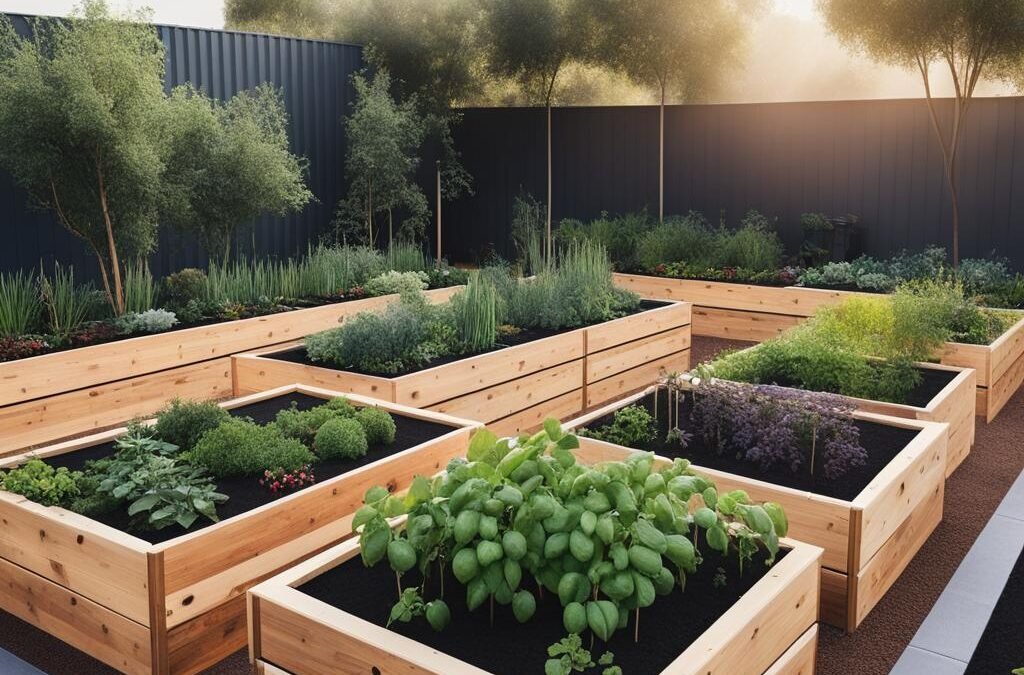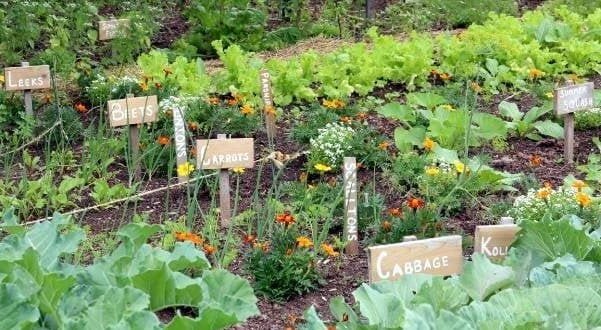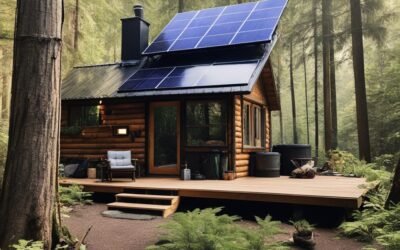As I look to the future of self-reliance and sustainability, envisioning my backyard brimming with vibrant greens and fruit-laden plants is not just a dream; it’s a mission. My quest to develop a self sufficient garden layout is fueled by the desire to pave a path for greater food autonomy right where I live. In constructing a sustainable garden design, the idea is not merely about planting seeds, but about sowing the seeds of independence and security.
In an era where our grocery shelves can turn barren because of unexpected events, my drive for backyard homesteading design is stronger than ever. Imagine the peace of mind that comes with knowing your next meal could be just right outside your door. And with techniques like the EarthBox® simplifying the self-reliant gardening equation, taking the first step toward this autonomy has never felt more attainable.
Key Takeaways
- Embrace a self sufficient garden layout to minimize dependency on grocery stores.
- Engage in sustainable garden design for heightened food security and self-reliance.
- Incorporate backyard homesteading design into your living space for a practical form of preparedness.
- EarthBox® gardening systems can greatly simplify the inception of sustainable gardening practices.
- A self-sustaining garden supports both the environment and your personal wellbeing.
Understanding the Importance of a Self Sufficient Garden
When I reflect on the harmony between human needs and nature’s bounty, there is an instinctive pull towards the wisdom of the past and the practices that safeguarded our forebears through tough times. It’s in this spirit that I’ve turned my patch of earth into not just a garden but a testament to self-reliance, diving deep into the world of permaculture garden layout, organic gardening tips, and regenerative agriculture practices.
The Role of Victory Gardens in History and Today
Victory Gardens, once a wartime necessity, are making a resounding comeback, not with the sound of strife but as a drumbeat for sustainability. They remind me of the resilience of generations before us, and now, they serve as a blueprint for my own garden, where each crop and curved bed is a step towards food sovereignty and reverence for the soil.
Promoting Food Security During Unforeseen Events
Every seed I sow is an insurance policy against uncertainty. The sprawling zucchinis and the stoic rows of kale in my garden are more than just food; they are my cushion against supply disruptions, my shield in the face of unforeseen events. I’ve learned this isn’t just about cultivation—it’s about cultivating readiness.
Health and Environmental Benefits of Sustainable Gardening
The payoffs of a self-sufficient garden aren’t limited to the dinner table. As I dig my hands into the earth and scatter seeds, I am also sowing the seeds of better health—for myself and the planet. This patch is my small yet powerful combatant against ecological degradation, a space where biodiversity thrives and where the ground is not just used, but improved.
| Permaculture Principle | Implementation in Garden | Environmental Benefit |
|---|---|---|
| Use and Value Renewables | Harvesting rainwater, solar pest control | Reduces reliance on non-renewable energy |
| Mimic Natural Ecosystems | Companion planting, natural pest management | Promotes biodiversity, pest balance |
| Produce No Waste | Composting, repurposing garden waste | Minimizes landfill contribution, enriches soil |
| Self-regulation & Feedback | Observation-led decision making | Prevents overuse of resources, encourages adaptation |
Designing Your Garden for Self-Sufficiency
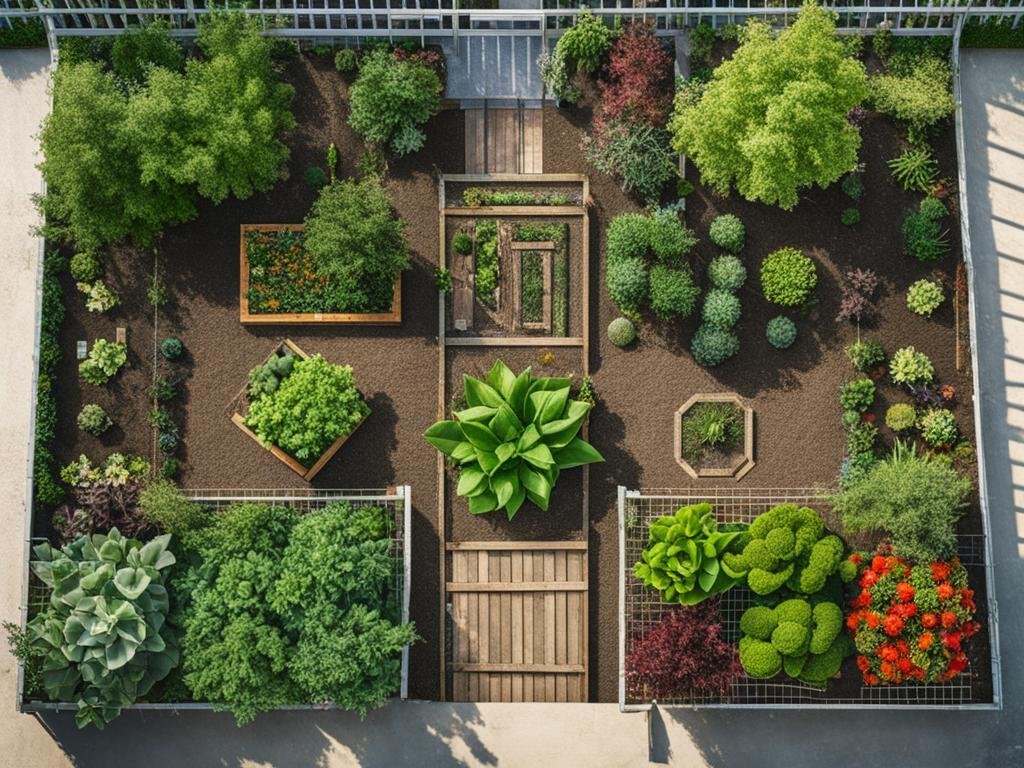 Embarking on a self reliance garden plan emboldens a partnership with nature, as I craft a personal oasis to nourish both body and spirit. My goal is to outline a series of eco-friendly gardening ideas that pave the way towards a flourish of self-sufficiency.
Embarking on a self reliance garden plan emboldens a partnership with nature, as I craft a personal oasis to nourish both body and spirit. My goal is to outline a series of eco-friendly gardening ideas that pave the way towards a flourish of self-sufficiency.
It all begins with solid groundwork—choosing just the right spot where my garden will thrive. From marking a sun-kissed plot to testing the soil’s embrace, each step further aligns with an ecological consciousness. Below is a tailored approach to ensure a bountiful yield with utmost respect for our planet.
- Site Selection: Harnessing the sun’s voyage across my patch of Earth, I highlight areas that drink in full sunlight, crucial for my chlorophyll-rich companions.
- Soil Assessment: A leap into the underground realm, gathering samples, discerning textures, and anticipating the needs through organic amendments.
- Plant Selection: I weave a tapestry of local flora, chosen for their resilience and rapport with regional climate patterns.
- Sustainability Practices: My devotion leads me to mulches, rain gardens, and companion planting. My garden’s blueprint is a mirror of the environment’s intrinsic systems.
In the table that unfolds, I align my methods with sustainable practices, cultivating an ethos of eco-consciousness entwined with bountiful yields.
| Element | Application in My Garden | Benefits |
|---|---|---|
| Companion Planting | Strategically placing plants together to detour pests and enhance growth | Reduction of pesticide use, promotion of biodiversity |
| Organic Mulch | Utilizing natural mulches like straw and leaves to suppress weeds and retain moisture | Improves soil quality, conserves water |
| Rainwater Harvesting | Installing barrels to collect rain, reducing runoff and reliance on tap water | Preserves precious water resource, decreases water bill |
| Native Plants | Selecting indigenous species for my self reliance garden plan | Requires less maintenance, supports local wildlife |
In my quest for an eco-friendly garden, the delicacy lies in harmonizing my aspirations with the inherent wisdom of nature herself. Thus, emerges a plot that’s both a canvas of my labor and a co-creation with the Earth—a testament to the resilience and beauty of life.
Planning Your Self Sufficient Garden Layout
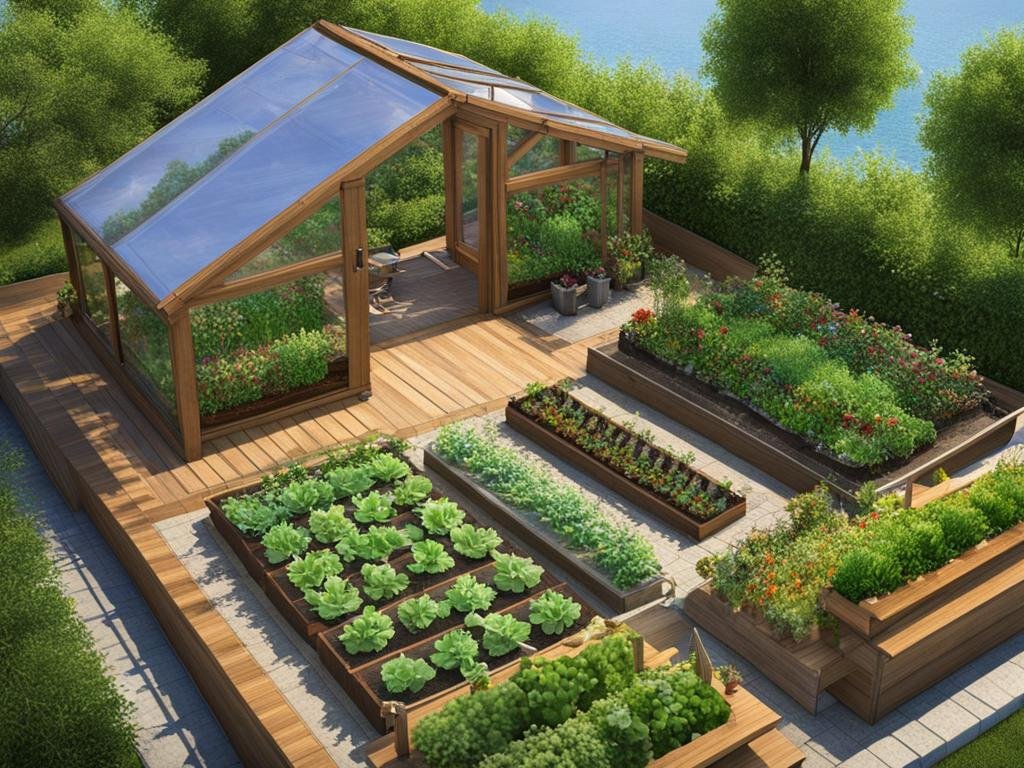 Creating a self sustaining garden blueprint has always been a dream of mine; not only does it pave the way for food security, it also imparts a sense of harmony with the natural world. With a focus on a low-maintenance food garden plan, I aim to share the essentials for crafting a green space that thrives with minimal intervention. Let’s delve into the essential steps for a garden that is both self-sufficient and easy to maintain.
Creating a self sustaining garden blueprint has always been a dream of mine; not only does it pave the way for food security, it also imparts a sense of harmony with the natural world. With a focus on a low-maintenance food garden plan, I aim to share the essentials for crafting a green space that thrives with minimal intervention. Let’s delve into the essential steps for a garden that is both self-sufficient and easy to maintain.
Selecting the Right Location for Sunlight and Drainage
Ensuring each plant gets the sunlight it needs while establishing proper drainage to prevent root rot can be a game changer for garden health. I’ve learned through experience that the right balance of light and water is crucial for plant success.
Choosing Plants That Thrive in Your Regional Climate
Respecting the local climate and ecosystem is paramount, and that’s why selecting the right plants is critical. From leafy greens for cooler climates to heat-tolerant veggies, every plant in my garden has a purpose and place.
Incorporating Permaculture Principles for Sustained Yield
The permaculture principles are my blueprints for an eco-friendly garden. By observing and following the natural patterns in my yard, I create a low-maintenance sanctuary that is productive and sustainable.
Here’s a quick glance at my essential checklist for a flourishing garden:
- Sun exposure assessment
- Soil fertility analysis
- Companion planting guides
- Water conservation tactics
These steps are not just tasks; they’re my route to creating a lush and abundant garden ecosystem. To illustrate my garden financing, I’ve put together a detailed table:
| Expense Category | Estimated Cost | Notes |
|---|---|---|
| Soil and Compost | $100 | Includes organic compost |
| Seeds and Plants | $50 | Region-appropriate varieties |
| Garden Tools | $70 | Essential tools only |
| Watering System | $30 | DIY drip system |
| Mulch | $20 | For moisture retention and weed prevention |
In the painting of my self-sufficient garden, each of these components is a stroke of color, blending together to create a harmonious and productive whole. With every seed sown and each plant nurtured, I am one step closer to a living tableau of sustainability and nourishment.
Essential Elements for an Eco-Friendly Gardening
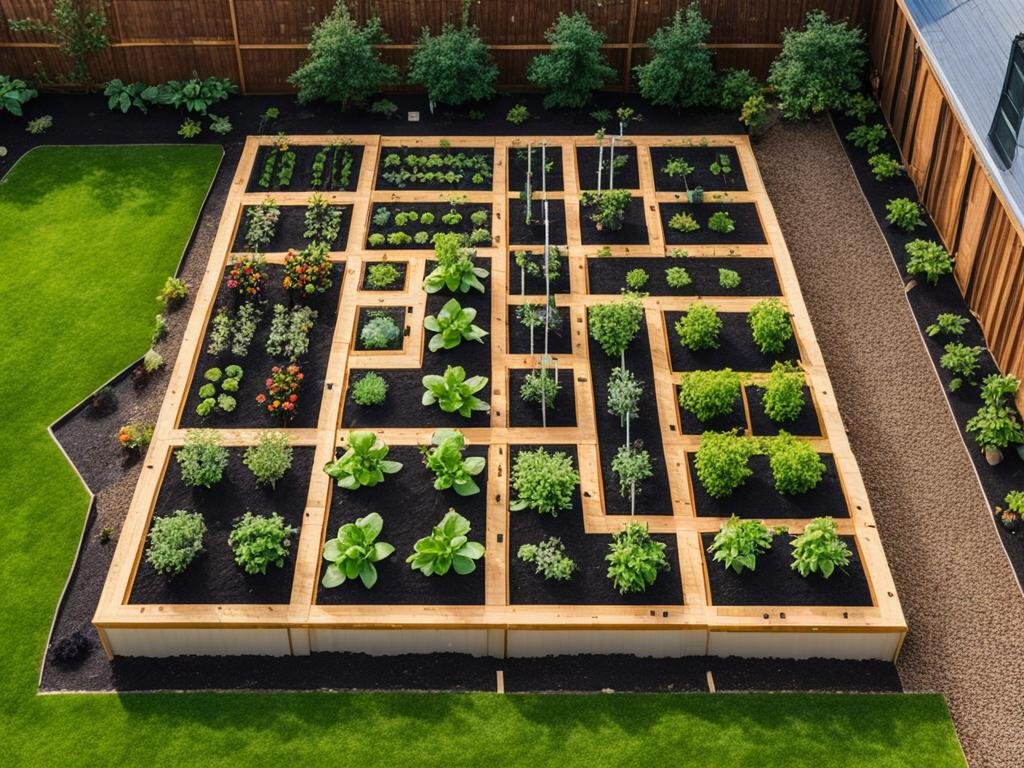 As I delve into the world of eco-friendly gardening ideas, I’ve discovered a myriad of ways to cultivate a thriving garden that aligns with nature rather than contests it. These methods not only foster a healthy ecosystem but ensure my garden is a model of sustainability. Today, I’d like to share some of these vital elements that any gardener can implement to create a low-maintenance food garden plan.
As I delve into the world of eco-friendly gardening ideas, I’ve discovered a myriad of ways to cultivate a thriving garden that aligns with nature rather than contests it. These methods not only foster a healthy ecosystem but ensure my garden is a model of sustainability. Today, I’d like to share some of these vital elements that any gardener can implement to create a low-maintenance food garden plan.
Composting is the cornerstone of an eco-friendly garden, transforming kitchen scraps and yard debris into nutrient-rich soil amendments. It’s a satisfying loop in the circle of life: your food waste nourishes the plants that, in turn, feed you.
Another core tenet is rainwater harvesting. It’s as simple as placing a barrel under a downspout. This practice conserves water, reduces runoff, and provides my plants with a more natural water source free from the additives of municipal supplies.
Successive sowing keeps my garden productive year-round. As one crop completes its cycle, I have the next ready to take its place. This method maximizes the use of my space and ensures that I’m never without fresh produce.
Utilizing recycled materials is not only environmentally friendly but also highly cost-effective. For example, I’ve used old yogurt containers as plant pots and repurposed wooden pallets into a charming, rustic garden fence.
By integrating these simple, earth-conscious practices into my daily gardening, I reduce my environmental footprint while contributing to a healthier planet.
Here’s an at-a-glance guide of elements to consider:
- Composting
- Rainwater harvesting systems
- Successive planting schedules
- Repurposing household items
| Eco-Friendly Practice | Benefits | Implementation Tips |
|---|---|---|
| Composting | Reduces waste, improves soil health | Use a balanced mix of greens and browns (kitchen scraps and yard waste). |
| Rainwater Harvesting | Conserves water, decreases runoff | Set up barrels or tanks at downspouts; use a mesh screen to keep debris out. |
| Successive Sowing | Continuous yield, optimized space | Plan ahead, prepare seedlings or seeds to plant as soon as one crop is harvested. |
| Recycling Materials | Reduces costs, minimizes waste | Get creative – use containers, packaging, and other materials for garden structures. |
All these components create a harmonious balance between my gardening ambitions and Mother Nature’s intricate web, ensuring a sustainable and fertile green space that will nourish my household for years to come.
Conclusion
As I reflect on the path I’ve taken to create my self sufficient garden layout, the satisfaction I feel is as rich as the soil I’ve nurtured. Each step, from considering the nuances of sustainable garden design to implementing organic gardening tips, has brought me closer to the dream of self-reliance. The garden isn’t just a plot of land; it’s a testament to the resilience and determination embedded in tending to life’s essentials with one’s own hands.
Gathering the Fruits: Reflecting on the Journey to Self Reliance
The bountiful harvest isn’t merely a collection of fruits and vegetables; it’s a cornucopia of lessons learned and personal growth. Each ripe tomato and crisp lettuce leaf carries the story of my commitment to a more autonomous lifestyle. The successes and setbacks faced along the way now bear fruit, both literally and metaphorically, reinforcing the empowering experience of backyard homesteading.
Future Enhancements: Considering Advanced Techniques and Technology
Looking ahead, I’m excited about further enhancing my garden’s productivity and ease of maintenance. Integrating advanced techniques like smart irrigation systems and exploring more sustainable garden design principles can significantly streamline my gardening process. The potential benefits of incorporating cutting-edge technology into an age-old practice promise not only increased yields but also more efficient water and resource management.
Sharing the Harvest: Community Engagement and Education
Sharing the knowledge I’ve gained is as important as sharing the harvest. Engaging with neighbors and local enthusiasts, I hope to sow seeds of sustainability within the community. Through education and collaborative efforts, we can cultivate a deeper understanding of eco-friendly practices, spreading the benefits of organic gardening tips far beyond the boundaries of my own plot. This exchange of ideas and experiences is the true bounty of a self sufficient garden layout, nourishing not just our bodies, but our collective spirit and responsibility towards the Earth.
FAQ
How do I start creating a self sufficient garden layout?
Begin by evaluating the space you have, taking into consideration the amount of sunlight and the soil quality. Then, identify plants that are suitable for your climate and design your garden to include a variety of food-producing plants along with sustainable elements like composting systems and rainwater collection setups. Utilize online resources or tools like EarthBox® to kickstart your backyard homesteading design.
What historical significance do Victory Gardens hold in relation to self-sufficiency?
Victory Gardens were popularized during the World Wars to reduce pressure on the public food supply and boost morale. Today, they serve as inspiration for creating self sufficient gardens that can provide security during crises, ensuring access to fresh produce when conventional supply chains are disrupted.
How can my garden contribute to environmental sustainability?
By implementing regenerative agriculture practices, you can ensure your gardening contributes to soil health, biodiversity, and the overall reduction of your carbon footprint. These practices include mulching, no-dig gardening, planting native species, and creating habitats for beneficial wildlife within your permaculture garden layout.
What are the most important considerations when designing a self-sufficient garden?
Important considerations include the selection of a location with plenty of sunlight and proper drainage; choosing resilient plants that are well-suited to your local climate; and integrating permaculture principles to create a symbiotic relationship between the garden’s various components.
Why is the right location crucial for a low-maintenance food garden plan?
The right location is critical because it affects the amount of sunlight and water your plants will receive, which are essential for their growth. Additionally, a well-drained area helps prevent diseases and promotes healthier plant roots, ultimately reducing maintenance efforts.
What are some eco-friendly gardening ideas that I can implement in my garden?
Some eco-friendly ideas include using natural pest control methods, composting kitchen and garden waste for nutrient-rich soil, practicing crop rotation, collecting rainwater for irrigation, and using mulches to conserve soil moisture and improve its health.
How can I ensure that the plants I select will thrive in my garden’s regional climate?
Research plants that are native to your region or have similar climate requirements. These plants are more likely to thrive with minimal intervention, making your garden more sustainable and easier to manage.
Can permaculture principles really make my garden low-maintenance?
Absolutely. Permaculture principles focus on creating a closed-loop system where the garden’s elements support one another, reducing the need for external inputs. This can include planting nitrogen-fixing plants to enrich the soil, using companion planting to deter pests naturally, and creating biodiversity to promote a healthy ecosystem.
What are the benefits of self reliance through gardening?
Benefits of self-reliance through gardening include reducing dependency on grocery stores, gaining control over what you eat by knowing how it’s grown, saving money on produce, and enjoying the physical and mental health benefits associated with gardening.
Where can I learn more about advanced techniques and technology for my garden?
You can explore agricultural extensions, gardening workshops, online courses, and forums that discuss topics such as smart irrigation systems, soil sensors, and more sophisticated methods of sustainable gardening for enhancing your self sustaining garden blueprint.
How can I engage my community in sustainable gardening practices?
Start by sharing your harvest and experiences with neighbors, friends, and family. Offer to help others start their own gardens, organize local workshops, or participate in community garden projects. Education and active engagement are key to inspiring and empowering community involvement in sustainable gardening.

